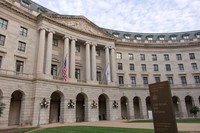Advertisement
Grab your lab coat. Let's get started
Welcome!
Welcome!
Create an account below to get 6 C&EN articles per month, receive newsletters and more - all free.
It seems this is your first time logging in online. Please enter the following information to continue.
As an ACS member you automatically get access to this site. All we need is few more details to create your reading experience.
Not you? Sign in with a different account.
Not you? Sign in with a different account.
ERROR 1
ERROR 1
ERROR 2
ERROR 2
ERROR 2
ERROR 2
ERROR 2
Password and Confirm password must match.
If you have an ACS member number, please enter it here so we can link this account to your membership. (optional)
ERROR 2
ACS values your privacy. By submitting your information, you are gaining access to C&EN and subscribing to our weekly newsletter. We use the information you provide to make your reading experience better, and we will never sell your data to third party members.
Environment
Trump EPA’s science rule on shaky legal ground
Federal court gives Biden-Harris administration an opening to suspend rule
by Cheryl Hogue
January 29, 2021

A federal court has handed the Biden-Harris administration a legal opportunity to release the Environmental Protection Agency from a controversial rule on the EPA’s use of science.
The rule was issued under the Trump administration and changes how the EPA weighs scientific information that underpins its regulations on pollution control and restriction of commercial chemicals. Under the rule, the EPA must give greater weight to studies based on data that are available for review. That presents a problem for epidemiological studies based on confidential health records.
Critics say the rule undermines the agency’s ability to protect public health and the environment. But supporters, including the US chemical industry’s largest lobbying group, the American Chemistry Council, say the rule strengthens the agency’s scientific basis for regulations.
The EPA issued the rule Jan. 6, making it effective immediately and thus binding on the Biden-Harris administration.
But a federal trial court in Montana found that the rule didn’t qualify to take effect immediately. Under federal law, only procedural rules qualify to take effect at once, the US District Court for the District of Montana says in a Jan. 27 order. The rule on EPA science “determines outcomes rather than process” and thus cannot be legally classified as a procedural rule, Chief District Judge Brian Morris wrote.
The court’s order provides two key opportunities for the Biden-Harris administration, which is reviewing the rule, to release the EPA from the new requirements.
First, the court determined the rule doesn’t take effect until Feb. 5. This is in keeping with the federal Administrative Procedure Act, which specifies that a nonprocedural rule—also called a substantive rule—goes into effect 30 days after an agency issues it.
That window gives the Biden-Harris administration an opening to suspend the rule while legal challenges to play out, explains Ben Levitan, senior attorney for the Environmental Defense Fund, which brought the case with two other advocacy groups. Such action would release the EPA from following the science rule until a court determines the rule’s legal status.
Second, the court’s ruling “undercuts the legal basis for issuing the rule at all,” Levitan says in a statement. To promulgate the rule, the EPA relied on the authority of an obscure federal law that is limited to procedural actions.
The court’s finding that the rule is substantive, not procedural, “casts into significant doubt whether EPA retains any legal basis” to issue the science rule, Morris wrote in the order.





Join the conversation
Contact the reporter
Submit a Letter to the Editor for publication
Engage with us on Twitter